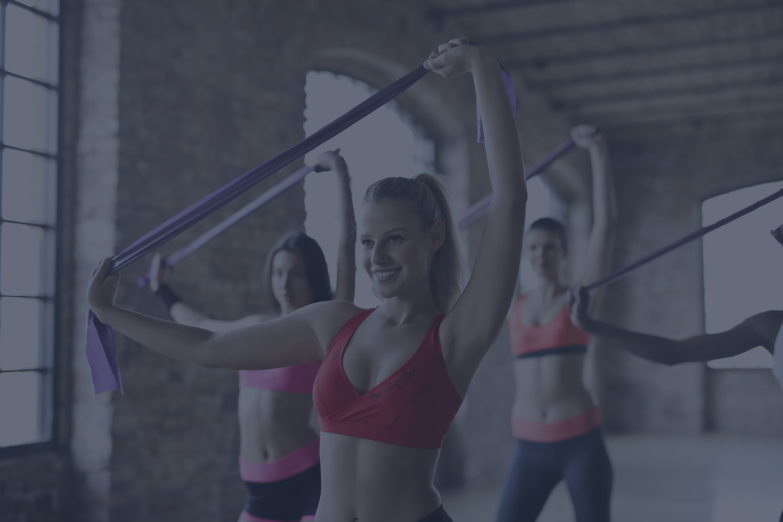
What are hip abductors? While they might not be something the everyday person thinks about, just ask any long-distance runner and they'll likely be able to explain, in great detail, why they are so important to know about.
Your hip abductors are the muscles in your hips (duh) that are required to move your legs away from the midline of your body. This means you use them for a ton of everyday movements like walking, getting in the car, or even getting yourself out of bed in the morning.
They also come into play to help athletes become better at running, cycling, stepping, lunging, and improve performance in virtually any sport.
By following these hips strengthening exercises regularly you can build your abductors at home using a few simple resistance bands.
What are hip abduction exercises good for?
The hip abductors are a group of muscles that help to create movement and stabilize your body as you perform other tasks. They're technically a part of your core and work with your abdominal and back muscles to provide core stability, build balance, and maintain good posture.
The four primary hip abductor muscles are:
- Gluteus Minimus
- Gluteus Medium
- Gluteus Maximus
- Tensor Fascia Lata
If you have weak hip abductors you will be more prone to injury, as it will put more pressure on your joints - specifically your knees, ankles, and feet.
Some injuries, like patellofemoral pain syndrome (knee pain, also known as runner's knee) and IT band syndrome are commonly experienced by runners with weak hip abductors.
Runners tend to have weaker glutes and very strong quadriceps. This uneven training wastes a lot of strength and means running at a slower pace. Improving your abductor strength will improve your speed, performance, and prevent joint injury.
How do you strengthen your hip abduction muscle?
The best way to strengthen your hip abductors is by incorporating exercises into your strength routine that activate these muscles regularly.
Simple exercises like squats are generally great, but they don't specifically focus on your hip abductors so you still end up with strength imbalances in your legs (stronger quads than abductors). You want to perform exercises that will isolate the abductor muscles to see your best results.
One-legged exercises are great as they require hip abductor activation in order to keep your body stable.
We've included the use of a hip band in our workouts for hips as it adds some resistance to help build your abductors and keeps these exercises from becoming too easy for you as your strength builds.
Hip Abduction Exercises
We've compiled four hip abduction exercises you can incorporate into your fitness routine to reap the benefits of strong abductors.
- For best results, perform these exercises 2-3 times a week on alternating days.
- Perform each exercise for 30 seconds, and then move on to the next.
- Go through the entire circuit 3 times.
Try the exercises for the first time without a band to get used to the movement and ensure proper form. Add in the bands as you become comfortable with the exercises and want the extra resistance.
Seated Hip Abduction with Resistance Band
- Sit down on a bench facing sideways.
- Step both feet into a resistance hip band and pull it up around your lower thighs.
- Step feet wider than hip-distance apart and point your toes outward slightly. Keep your knees over your toes.
- Pull your knees away from each other and feel the resistance from the band. Be sure to keep your feet on the floor, but they can tilt outward slightly.
- Return to the beginning position.
Side-Lying Hip Abduction with Resistance Band
- Lie down on an exercise mat. Start with your right side on the ground, and keep your hips in line with your body. Use your right arm under your head for support, and place your left arm on your left hip.
- Place a resistance band around both legs at thigh level.
- Bend your bottom (right) knee, and straighten out the left.
- Lift your left leg, keeping it in line with your hip. Don't lean forward or back. Lift leg to 45° at your side. This is as far as the hip abductors can be engaged before it starts to involve other hip muscles instead.
- Return to starting position.
- Remember to perform the exercise on both sides of your body.
Clam Shells with Resistance Band
- Lie down on an exercise mat. Start with your right side on the ground, and keep hips in line with the rest of your body. Keep right arm under your head, and left arm on your hip. This is the same setup as the previous exercise.
- Place a resistance band around both of your thighs.
- Bend both of your knees and stack feet on top of each other.
- Without lifting your feet, open your top thigh and lift the left knee towards the ceiling.
- Return your leg to starting position.
- Perform exercise on both sides of the body.
Resisted Crab Walk
- While standing, put both feet through the resistance band. Pull it up around your thighs.
- Place hands in a prayer shape in front of your chest, and keep your legs shoulder-distance apart.
- Squat by bending your knees. Keep your knees in line with your toes, stick your butt out slightly while tucking your hips under to protect the lower back.
- Step out to the right side with your right foot.
- Follow by stepping the left foot to the right side too, so that your knees are once again under your shoulders.
- Continue in one direction for 30 seconds.
- Reverse directions.
Hip abduction exercise takeaway
With regular use, these exercises will help you to prevent joint injury and take your running and cycling performance to new heights!









Leave a comment (all fields required)